TITAN Olympic plates vs Rogue bumper plates
This is a comparison between the TITAN Olympic plates and the Rogue bumper plates including pros, cons, and alternatives. It was published first under which titan plates to get. Follow the links for more details.

Rogue fitness vs TITAN fitness
Rogue Fitness is the current market leader when it comes to a functional home gym and commercial gym equipment. They have one of the widest portfolios including racks, barbells, benches, dumbbells, and apparel for the weekend warrior and dedicated athlete. The biggest downside of Rogue Fitness is their comparatively high prices to the competition.
TITAN Fitness is the clear cost leader when you want to build a home gym on a budget that is still similar to what Rogue offers in function, look, and feel. While you will save about half on the sticker price you will run a higher risk of inconsistencies in quality compared to a purchase from Rogue. The equipment will be safe but is more likely to have blemishes, quality issues with welds or that pieces will not easily fit into place. That makes TITAN a good option for a DIY enthusiast who does not mind tinkering with their equipment, but not the first choice to get the best equipment and treat yourself.
Overview and review of the Rogue Bumper plates
The Rogue bumper plates will set you back about $565 dollars or $3.76 dollars per kg. These plates are especially good to use for all purposes in commercial gyms. This overview has originally been published in the article "Which rogue plates to buy" which you can find on this blog.
What else to consider from Rogue
Overview of the Rogue Bumper plates
The
HG Bumper plates are the workhorse in the plate portfolio of Rogue. If you want cheap plates with a three-year warranty which do the job, this is your place. These plates will last, can be abused in any kind of way and will perform. The disadvantages of these plates are that they are harder to handle than
6 shooters and do are as plain as they come. They score 88 points on the durometer scale and have therefore slightly more bounce than the high range options from Rogue. The only color option for these plates is black.
Weight / Diameter / Thickness / Price per pair
25kg / 450mm / 3.5'' / $162.50
20kg / 450mm / 3.25'' / $130
15kg /450mm / 2.625'' / $97.50
10kg / 450mm / 1.75'' / $63
5kg / 450mm / 1'' / $52.50
Available sets
90kg, 2x 10-15-20 kg $370
110kg, 2x 10-20-25 $437.50
120kg, 2x 15-20-25kg $460
140kg, 2x 10-15-20-25kg $525
150kg, 2x 5-10-15-20-25kg $565
This is the no-nonsense choice if you are starting out and just want weight.
Pros of the Rogue bumper plates
These plates will not oxidate and can be used outside. If they reak your heart won't sink and you just replace them. They will be forgiving when dropped on feet or on the skin. Hurting your fingers is less likely than with other plates. You can drop them from overhead. Take your pic.
Cons of the Rogue bumper plates
These plates look dull and you can not see what you have exactly loaded. You also will not fit as much weight on the
bar than with higher price ranged options from Rogue. It is also more likely with these plates, tat
th weight varies more considerably compared to what is stated on the plate.
Alternatives to the Rogue bumper plates
The
6 Shooter Urethane plates are another workhorse option with a different design. The six holes make it easier for athletes to handle the weight. These plates can also be used for workouts without a
barbell, which is hard to do with
bumper plates.
Olympic weights are the ultimate plate for getting as much weight as possible on your
bar at minimum cost. These metal plates are not fancy, but weigh a lot while not taking up a lot of space on the
bar. If your gym should make clanging and banging noises, this is the plate to get.
Competition plates are the Nascar version of
bumper plates. These plates are color coded so you can easily see how much weight is on the
barbell. They also have a steel core which makes them behave better when you change direction for the Olympic lifts.
Overview and review of the TITAN Olympic plates
This is an overview of the TITAN Olympic plates including pros, cons, and alternatives. It was published first under which titan plates to get. Follow the links for more details.
Related articles
Overview of the Olympic bumper plates
Price $119.99 - $999.99
The
TITAN Olympic bumper plates come in sizes ranging from 10LB - 55lb and follow the
color coding of international lifting competitions for the various plates. These plates work with rubber on the outside and a steel collar in the middle for stability and minimum bounce. This is the closest you can get in the TITAN portfolio to international weightlifting competition standards. The full specifications of these plates are:
Color-coded in vibrant colors for easy identification.
Precise 50.6 mm collar diameter for a secure fit on your barbell.
The steel collar reinforces the plates for high rep use.
Raised plate lip makes picking up the plates easier.
General Specifications:
Plate Diameter: 450 mm (execpt 10 LB)
Weight Tolerance: +/- 20 grams.
Collar Opening: 50.6mm
Insert Type: Steel disc
Durometer Rating: 90
Material: Rubber
10 LB:
Plate Diameter: 360 mm
Plate Width: 1"
Color: Grey
25 LB:
Plate Width: 1.375"
Color: Green
35 LB:
Plate Width: 1.875"
Color: Yellow
45 LB:
Plate Width: 2.15"
Color: Blue
55 LB:
Plate Width: 2.5"
Color: Red
This is a good option to save money if you want competition plates for your home gym or in your commercial gym. Be aware though, that these plates are not IWF approved. They get close, but you will not be able to either use them in an official IWF competition or to simulate the conditions for your athletes as close as possible.
Pros of the TITAN Olympic bumper plates
- Price
- Colors
- Low bounce
- Optimized thickness
The main thing that most TITAN products have going for themselves is that they are about half the price of anything that is comparable in the market. These are a great option to save money and either get more plates for the same budget or upgrade from regular bumper plates to competition plates on the same budget. Rogue and Eleiko charge considerably more for similar products.
Compared to other plates from the TITAN line up the main advantage of these plates are the vibrant colors.
Urethane is harder to colorize than rubber in the production process and the
elite bumper plates and
economy plates are mainly sold in black. If the colors of our plates is something you really care about then these are a good choice.
Apart from this these plates are also optimized to take up the least space possible on your barbell sleeve while still being rubber. This combined with a low bounce makes the competition bumper plates a good choice for anyone who is serious about Olympic weightlifting.
Cons of the Olympic bumper plates
- IWF Approval
- Sleeve space
- Durability
The biggest con against the
TITAN Olympic bumper plates is that they are not IWF approved. If you are intending to simulate competition conditions in your gym or even hold competitions yourself, these plates are not ideal. For this purpose, the Eleiko or Rogue sets are the better options, as they went through the necessary certification process with the IWF to be accepted. If you already consider competition plates, you probably take your lifting very, very serious. To me, it does not make sense to save money, if you want to simulate competition as close as possible. Still, saving half the price on such a big item for your gym is not to be scoffed at.
Compared to
cast iron plates competition bumper plates still take up more space on the sleeve of the barbell and create more whip. If you regularly move more than 400lbs on the squat, bench press, and deadlift these plates might not be the right choice for you. You will not fit enough of them on the bar and they will also make the bar bend more as the weight will be distributed further out.
The last thing against competition plates is that they generally have a bigger tendency to break than
urethane plates when dropped from overhead. This is a minor difference, but if you want long-lasting training plates, go for
urethane and keep one proper competition set up in your gym to save on cost but still being able to simulate competition for your athletes. In a home gym setting, I would question
urethane and competition plates in general as too high of an expense, unless you are a professional athlete or just like the good things in life and don't care about the money.
Alternatives to the TITAN Olympic bumper plates
The
TITAN economy bumper plates are the best option to save money and have them around for all purposes. These plates can be used indoors and outdoors and you do not have to feel too bad when they break, as they come cheap. The downside is that they have more bounce than competition plates, usually do not come
color-coded, and are way more likely to warp or come loose in the center.
The
TITAN elite bumper plates are in my opinion the best option for the ambitious home gym athlete. You are not a professional, but also have the budget and the performance to back up a semi-professional home gym setup. In a commercial setting, these are the right toys for your top tier clients that are dedicated and want to set themselves apart from the occasional gym lifter. They cost more than regular bumpers but also do not go beyond $1000 for a good-sized set.
Urethane bumper is the best choice for a commercial gym that has
Olympic lifts going on all day long. The colors are a little less vibrant than on the competition plates and they are slightly more expensive, but in return, these plates last for a very long time. In a home gym scenario, you are probably better of with competition plates, if you are already willing to spend close to $1000 or more on your plates as your training frequency won't be as high as in a commercial gym.
Cast Iron plates are the best options for powerlifters. If you regularly move more than 400lbs on the bar you want to optimize sleeve space and minimize the whip in the bar.
Cast iron plates are the best option for this. They also take up less space on plate trees and storage pins for the same amount of weight. The only downside is that they can not be dropped from overhead and need special flooring unless you want to wreck the plates and the floor at the same time.
Conclusion for the Olympic bumper plates
I am personally not a fan of the
TITAN Olympic plates as they are not IWF approved. They match the specs and this will not necessarily reflect that much in the handling of the weight, but still, if you are willing to pay extra for competition plates, can get plates you will actually use in competition. Otherwise, you might as well opt for
Elite bumpers or
Urethane plates. If you are already of a competitive mindset, you probably will not decide based on budget. But that is just me talking.

